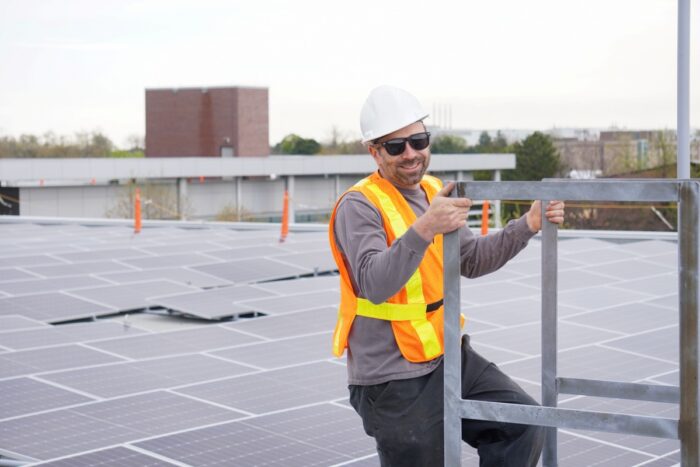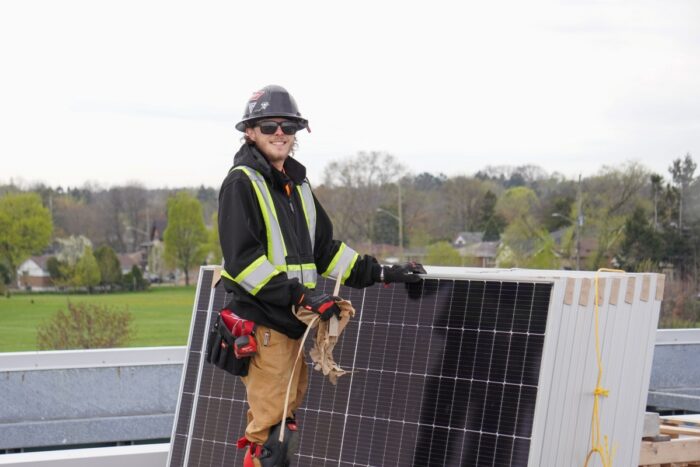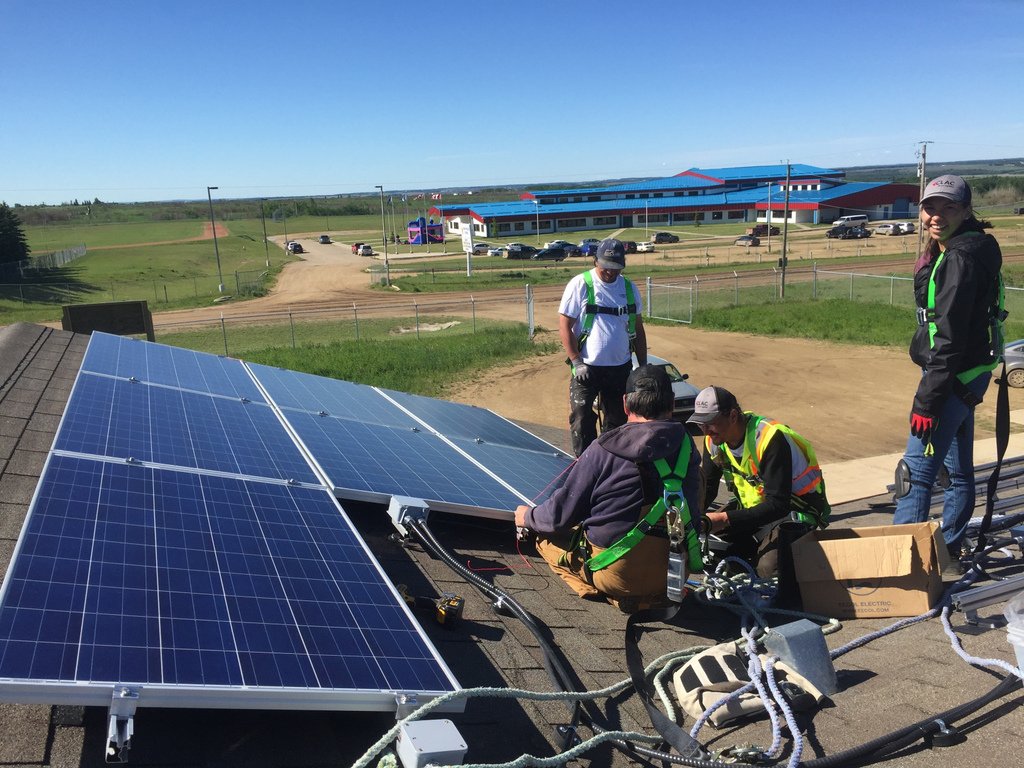How Canadian solar installers tame Old Man Winter

Canadian solar installers have learned how to tame Old Man Winter with advanced planning and design so that they can operate during the season under some of the harshest weather conditions on the continent.
“With with the Greener Homes loan program going away, this year has been a major push for everybody who wanted to get in before it closed. It’s been a major boom year for sales,” says Brett Piercey, co-founder of Nuvo Renewables, which was formed by a group of solar veterans and is based in Calgary, Alberta.
“Over the next couple of years, we see the market not necessarily retracting for residential but growing faster on the C&I side,” Piercey predicts. However, “right now is kind of a lull period in the solar coaster, as they put it,” he adds.
Winter can also be a lull period in Alberta. “Since Calgary is right off the edge of the Rocky Mountains, we get a ton of Chinook winds. So when it comes down to average temperatures and snow, Calgary is quite warm actually, throughout the winter,” says Piercey. Still, winter starts as early as October and ends as late as May, delivering an average of 3.4 meters or 134 inches of snow per year.
In eastern Canada, winters sometimes vary more. “Winters in Ontario can be on the mild side but sometimes they can be quite severe,” observes Zac Jolliffe, the business development manager for VCT Group, based in Waterloo, Ontario. “Last winter, we had a lot of snow and no periods of melt for about three months or so throughout the thick of the winter,” he recounts.
“We had a few projects that just didn’t produce anything during January and February this past winter,” Jolliffe notes. VCT Group is an EPC as well as a product supplier based in the Waterloo region of Ontario, which has been in business for 17 years with over 300 installs, focused on C&I, including the municipal market.
Estimating snow loss
Anticipating a heavy snow year during the design phase can be challenging. “When we’re modeling the productivity of our systems, we’re discounting more than half of the possible production from a system throughout December, January and February each year,” Jolliffe says.
“We do that to make sure that we are conservative with our production estimates,” Jolliffe says. “I would encourage system designers to not accept whatever your software says a system is going to produce. Look at look at historicals from built systems, look at what happens in the winter, and see if your estimates are really accurate. Don’t over-promise your customers,” he recommends.
Estimating generation loss from snow load is necessarily a localized art. “For us in Calgary, I would say our generation loss is between 40% and 50% in February, our snowiest month, in terms of historical averages. Then in November, December, and January we see an average of only about 26% in losses,” Piercey says.
“As soon as the temperature gets above zero, a lot of the snow actually melts off the roof by itself, long as it’s not a low pitch roof,” Piercey says. “We are quite sunny during the winter months,” he adds.
Solar car ports may shed snow faster than rooftop arrays, points out Jolliffe. “The carports we design have very little shading on the backside. And a bifacial panel, even when there’s snow coverage on top, will still activate through ambient light [albedo] on the bottom of the panel. Whenever panels make electricity, they make heat as well, so we tend to see our carports clearing a lot quicker than a rooftop installation in the same area,” he says.
Ice formation is also a consideration in car port design. “Most solar car ports have a gap between panels that will allow drips to come through and turn into ice. But our patented car port gutter system catches all that water as it comes down between the panels and moves it to the edge of the array. We have built systems that have been out in the wild for five full Canadian winters, and those systems do not leak,” Jolliffe points out.
Designing for customer use
Design is a big part of weathering winter in Alberta. “When we design projects, we look at the business case and the feasibility of the project, and we are accounting for additional scale coverage compared to whatever the design software says we’re going to get,” says Jolliffe.
“Regardless of whatever our software says we’re going to get out of the system, we always put a custom set of soiling conditions over the top of that,” he adds.
“There’s a very good grant in Ontario right now for non-exporting solar arrays for businesses, so a lot of what we’re designing is load displacement rather than a metering system. In that case, design is a very different process, where you have to look at the demand profile of a site and how much power they’re consuming at different points throughout the year,” Jolliffe says. “You design around their demand profile, rather than just their total consumption,” he explains.
Others agree that interpreting modeling software is critical to tightly designed installations with heavy winter exposure. “We use Aurora Solar, an industry standard for design, and we make sure that we model everything absolutely perfectly,” allows Piercey.
Regulations in Alberta dictate an array production of no more than 104% of a host building’s annual energy consumption, so system design has tight parameters in the province. “We don’t want to sell somebody a system that’s going to be more expensive just to produce just that little bit of extra electricity,” he notes.
“We make sure that if we have to put a panel in a sub-optimal spot, we warn the customer that the panel is going to cost more per kilowatt-hour than it produces compared to the rest of the system,” Piercey explains. “Then we show them [on screen] what the system could do if we were to remove that panel,” he says.

Advance planning for installs and rate options
While rooftop installations may continue during long freezing periods, work on ground mounted systems comes to a standstill as winter sets in. “Once we hit mid October to November, it starts to get a little dicey with anything involving ground works,” says Piercey. “You’re not really going to be starting a ground mount in the dead of winter. You can’t trench because of the frost line without absolutely ripping the ground apart. So what we’ll try to do is make sure that we get everything [foundations] in place before the actual install goes ahead,” he explains.
Down-filled overalls are a standard issue for outdoor workers in winter, but snow conditions may dictate staying off the roof and switching focus to warehouse work. “If we have a minus 30 degree day and it’s dumping snow, there is really no point to going out there to install; you’re going to spend more time clearing snow than you are actually doing the install,” says Piercey. “We don’t want to have guys out doing that; it’s just bad for morale,” he adds.
Planning for electricity rate switching is also a key to surviving the winter months. “When you’re exporting more than you’re importing in the summer, you may want to switch to a 30 cents per kilowatt-hour rate; the utility has to pay you back at 30 cents a kilowatt-hour. That’s where you make up the majority of your credits that are going to carry you through the winter,” Piercey calculates.
Fewer failures and longer warranties
Continuing improvements by equipment manufacturers also help Canadian installers on the long term. “A lot of the manufacturers these days are really stepping up their product warranties as their manufacturing processes has improved. We’ve seen far less failures over the last couple of years than we saw previously,” Piercey says. “We’re seeing equipment that used to carry a 10-year warranty now carrying a 25-year warranty. APS, for instance, just bumped up their micro inverter warranties to 25 years,” he points out.
Nuvo provides seamless service when there is an equipment failure, Piercey says. “We absolutely handle everything if there’s an issue with the system. We try to catch it before the clients do and make sure that we reach out to the manufacturer, get it all approved, and then schedule it as soon as possible for the client,” he explains.
VCT utilizes a large database of its installs to help design new projects, which also helps minimize O&M costs, which the company absorbs for the first two years. “We monitor and maintain a couple of hundred systems in Ontario, with lots of historical data on production of systems throughout the year, including the winters,” says Jolliffe.




